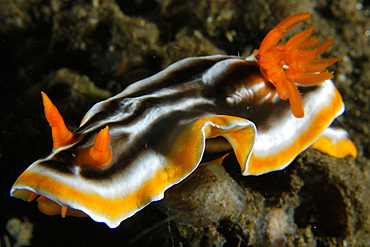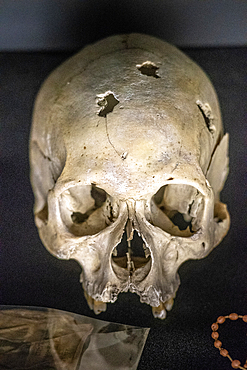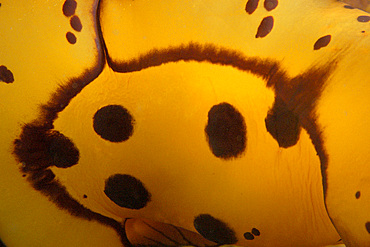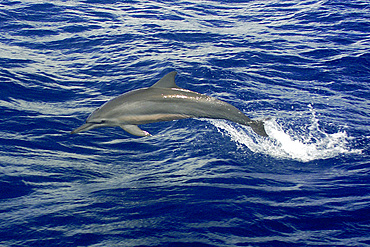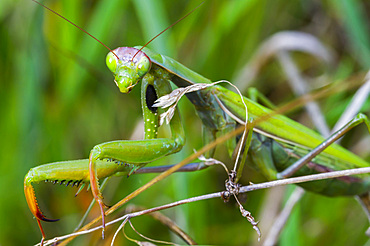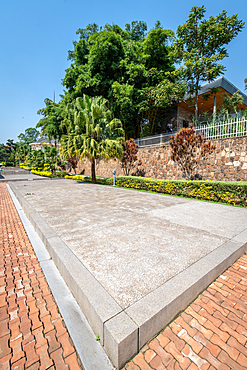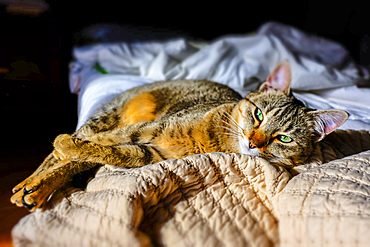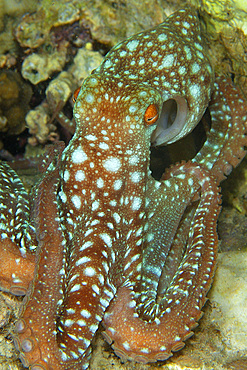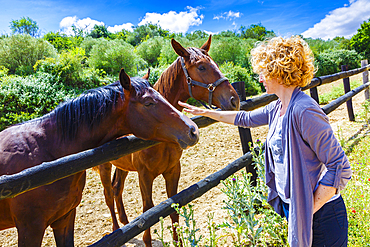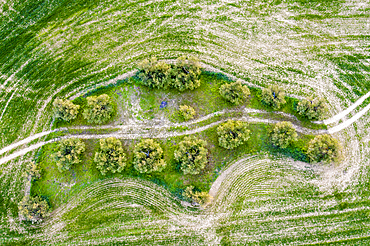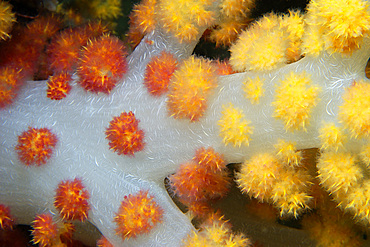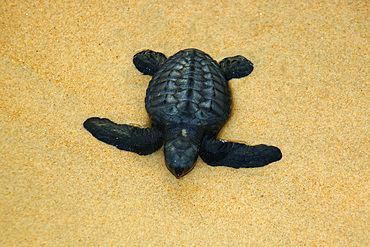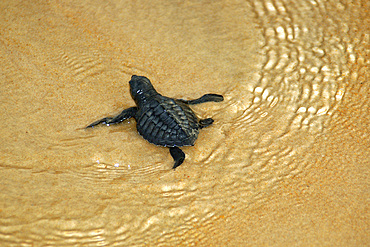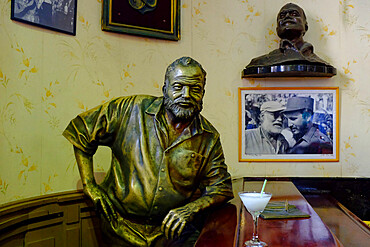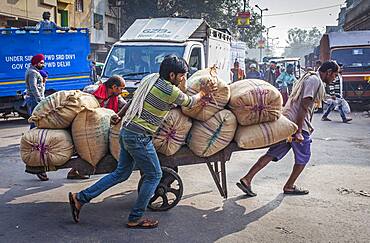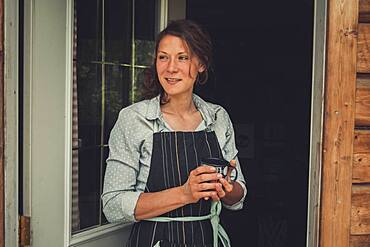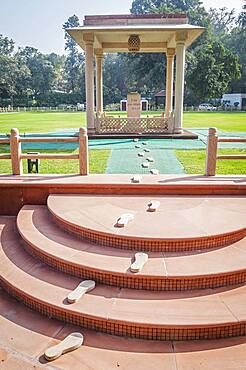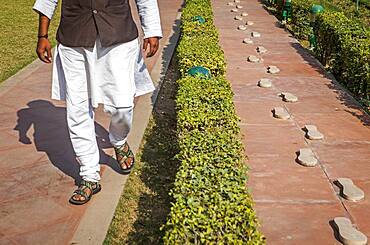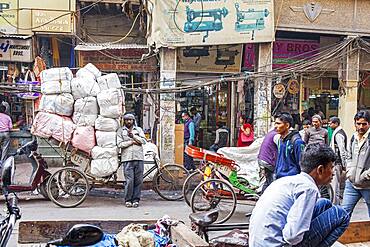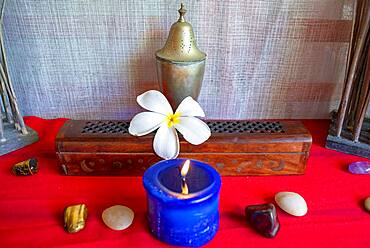Recent searches
Loading...
1350-2729 - The remains of known victims of the 1994 Rwandan Genocide remain interred and on display inside of of the Kigali Genocide Memorial as a testament to those lost in the brutality, Kigali, Rwanda.
1350-2466 - Pair of wire coral gobies, Bryaninops yongei, on wire coral, Cirripathes anguina,Ailuk atoll, Marshall Islands, Pacific
1350-2695 - Verges, a small town in the Northeast of Catalonia (Spain), during Easter celebrates the Procession of Verges with skeletons dancing on the sound of a drum, Roman soldiers, known as the 'Manages', and a representation of the life and crucifixion of Jesus Christ. The Procession features the Dance of Death, a tradition from the Middle Age associated with epidemics and plagues and the only one remaining in Spain Ten skeletons dance to the beat of a drum to remember that no one is exempt of death. The backdrop of the medieval walls and towers of Verges is key to this macabre staging.
1350-2715 - Damaged skulls of known victims of the 1994 Rwandan Genocide remain interred inside of of the Kigali Genocide Memorial as a testament to those lost in the brutality, Kigali, Rwanda.
1350-2583 - Bottlenose dolphin, Tursiops truncatus, Oahu, Hawaii (N. Pacific).
1350-2524 - Nudibranch, Chromodoris magnifica, Dumaguete, Negros Island, Philippines.
1350-2546 - Feather star, possibly Oxycomanthus bennetti, West Escarceo, Puerto Galera, Mindoro, Philippines.
1350-3463 - Vineyard in autumn and church. Monastery of Irache. Ayegui, Navarre, Spain, Europe
1350-2532 - Mandarinfish, Synchiropus splendidus, male, Malapascua, Cebu, Philippines, Visayan Sea.
1350-3408 - Plums and Custard or Red-haired agaric (Tricholomopsis rutilans) mushrooms. Gorbea Natural Park. Alava, Spain, Europe
1350-3784 - Ice cream woman seller in America Central Park, Quetzaltenango city Guatemala.
1350-2716 - Damaged skulls of known victims of the 1994 Rwandan Genocide remain interred inside of of the Kigali Genocide Memorial as a testament to those lost in the brutality, Kigali, Rwanda.
1350-2541 - Pleurobranch sidegill slug, Berthella martensi, mantle detail, Puerto Galera, Mindoro, Philippines.
1350-3458 - Vineyard in autumn. Ayegui, Navarre, Spain, Europe
1350-2427 - Green sea turtle, Chelonia mydas, gets cleaned by yellow tangs, Zebrasoma flavescens and lined bristletooth, Ctenochaetus striatus, Kailua-Kona, Hawaii, (N. Pacific)
1350-2449 - Spinner dolphin, Stenella longirostris, Namu atoll, Marshall Islands (N. Pacific).MID0042
1350-2723 - Photographs of known victims of the 1994 Rwandan Genocide line the walls of the Kigali Genocide Memorial, Kigali, Rwanda.
1350-3442 - Cyclist and sunflowers crop, Sorlada village and San Gregorio monastry. Tierra Estella. Navarre, Spain, Europe
1350-2511 - Family of false clown anemone fish, Amphiprion ocellaris, seeking refuge in sea anemone, Masaplod, Dumaguete, Negros Island, Philippines.
1350-2460 - Pink hydrocoral (lace coral), Stylaster sp., Namu atoll, Marshall Islands (N. Pacific).
1350-3490 - Farmland with vineyard and road. Iguzquiza, Navarre, Spain, Europe
1350-2426 - Green sea turtle, Chelonia mydas, gets cleaned by yellow tangs, Zebrasoma flavescens and lined bristletooth, Ctenochaetus striatus, Kailua-Kona, Hawaii, (N. Pacific)
1350-3487 - Reedbed and river. Alloz reservoir. Navarre, Spain, Europe
1350-2690 - Verges, a small town in the Northeast of Catalonia (Spain), during Easter celebrates the Procession of Verges with skeletons dancing on the sound of a drum, Roman soldiers, known as the 'Manages', and a representation of the life and crucifixion of Jesus Christ. The Procession features the Dance of Death, a tradition from the Middle Age associated with epidemics and plagues and the only one remaining in Spain Ten skeletons dance to the beat of a drum to remember that no one is exempt of death. The backdrop of the medieval walls and towers of Verges is key to this macabre staging.
1350-2504 - Family of false clown anemone fish, Amphiprion ocellaris, seeking refuge in sea anemone, Dumaguete, Negros Island, Philippines.
1350-2727 - The remains of known victims of the 1994 Rwandan Genocide remain interred and on display inside of of the Kigali Genocide Memorial as a testament to those lost in the brutality, Kigali, Rwanda.
1350-2547 - Reef wall covered with soft corals and gorgonians, mainly orange cup coral, Tubastrea faulkneri, Verde Island, Philippines.
1350-3414 - European mantis or praying mantis (Mantis religiosa).
1350-3479 - Agricultural aerial landscape, Tierra Estella, Navarre, Spain, Europe
1350-3783 - Malted milk woman seller in America Central Park, Quetzaltenango city Guatemala.
1350-2691 - Verges, a small town in the Northeast of Catalonia (Spain), during Easter celebrates the Procession of Verges with skeletons dancing on the sound of a drum, Roman soldiers, known as the 'Manages', and a representation of the life and crucifixion of Jesus Christ. The Procession features the Dance of Death, a tradition from the Middle Age associated with epidemics and plagues and the only one remaining in Spain Ten skeletons dance to the beat of a drum to remember that no one is exempt of death. The backdrop of the medieval walls and towers of Verges is key to this macabre staging.
1350-2721 - Mass graves outside of the Kigali Genocide Memorial, Kigali, Rwanda.
1350-2726 - Damaged skulls of known victims of the 1994 Rwandan Genocide remain interred inside of of the Kigali Genocide Memorial as a testament to those lost in the brutality, Kigali, Rwanda.
1350-2687 - Verges, a small town in the Northeast of Catalonia (Spain), during Easter celebrates the Procession of Verges with skeletons dancing on the sound of a drum, Roman soldiers, known as the 'Manages', and a representation of the life and crucifixion of Jesus Christ. The Procession features the Dance of Death, a tradition from the Middle Age associated with epidemics and plagues and the only one remaining in Spain Ten skeletons dance to the beat of a drum to remember that no one is exempt of death. The backdrop of the medieval walls and towers of Verges is key to this macabre staging.
1350-2689 - Verges, a small town in the Northeast of Catalonia (Spain), during Easter celebrates the Procession of Verges with skeletons dancing on the sound of a drum, Roman soldiers, known as the 'Manages', and a representation of the life and crucifixion of Jesus Christ. The Procession features the Dance of Death, a tradition from the Middle Age associated with epidemics and plagues and the only one remaining in Spain Ten skeletons dance to the beat of a drum to remember that no one is exempt of death. The backdrop of the medieval walls and towers of Verges is key to this macabre staging.
1350-2712 - Names of known victims of the 1994 Rwandan Genocide lines the walls of the Kigali Genocide Memorial, Kigali, Rwanda.
1350-2696 - Verges, a small town in the Northeast of Catalonia (Spain), during Easter celebrates the Procession of Verges with skeletons dancing on the sound of a drum, Roman soldiers, known as the 'Manages', and a representation of the life and crucifixion of Jesus Christ. The Procession features the Dance of Death, a tradition from the Middle Age associated with epidemics and plagues and the only one remaining in Spain Ten skeletons dance to the beat of a drum to remember that no one is exempt of death. The backdrop of the medieval walls and towers of Verges is key to this macabre staging.
1350-2513 - Common lionfish, Pterois volitans, blends in with a variety of soft corals and sponges, Cars, Dumaguete, Negros Island, Philippines.
1350-2534 - Starry night octopus, Octopus luteus, foraging on coral reef at night, Malapascua, Cebu, Philippines, Visayan Sea.
1350-2512 - Family of false clown anemone fish, Amphiprion ocellaris, seeking refuge in sea anemone, Masaplod, Dumaguete, Negros Island, Philippines.
1350-2505 - Anemone fish, Amphiprion sp., Dumaguete, Negros Island, Philippines.
1350-2697 - Verges, a small town in the Northeast of Catalonia (Spain), during Easter celebrates the Procession of Verges with skeletons dancing on the sound of a drum, Roman soldiers, known as the 'Manages', and a representation of the life and crucifixion of Jesus Christ. The Procession features the Dance of Death, a tradition from the Middle Age associated with epidemics and plagues and the only one remaining in Spain Ten skeletons dance to the beat of a drum to remember that no one is exempt of death. The backdrop of the medieval walls and towers of Verges is key to this macabre staging.
1350-3422 - Horses on a farm. Dicastillo. Estella comarca, Navarre. Spain, Europe
1350-2555 - Clark's anemonefish, Amphiprion clarkii, unusual color variant, male, Dauin, Negros, Philippines..
1350-2694 - Verges, a small town in the Northeast of Catalonia (Spain), during Easter celebrates the Procession of Verges with skeletons dancing on the sound of a drum, Roman soldiers, known as the 'Manages', and a representation of the life and crucifixion of Jesus Christ. The Procession features the Dance of Death, a tradition from the Middle Age associated with epidemics and plagues and the only one remaining in Spain Ten skeletons dance to the beat of a drum to remember that no one is exempt of death. The backdrop of the medieval walls and towers of Verges is key to this macabre staging.
1350-3478 - Agricultural aerial landscape, Tierra Estella, Navarre, Spain, Europe
1350-2474 - Reef octopus, Octopus cyanea, eye and siphon detail, Rongelap, Marshall Islands, Micronesia
1350-2467 - Cushion star, Culcita novaguineae, skin texture, Ailuk atoll, Marshall Islands, Pacific
1350-3417 - Sprig of grapes in a vineyard. Villamayor de Monjardin. Navarre, Spain, Europe
1350-2531 - Soft coral, Dendronephthya sp., Lapus Lapus Island marine park, Malapascua, Cebu, Philippines.
1350-2577 - Pink anemonefish, Amphiprion perideraion, in sea anemone, Great barrier reef marine park, Australia (South Pacific).
1350-2714 - Damaged skulls of known victims of the 1994 Rwandan Genocide remain interred inside of of the Kigali Genocide Memorial as a testament to those lost in the brutality, Kigali, Rwanda.
1350-2535 - Nudibranch, Jorunna funebris, feeding on blue sponge, Haliclona sp., Monkey beach, Puerto Galera, Mindoro, Philippines.
1350-2471 - Wave breaking over shallow coral reef, Ailuk atoll, Marshall Islands, Pacific
1350-2554 - Pair of false clown anemonefish, Amphiprion ocellaris, in anemone, Daiun, Negros, Philippines.
1350-3407 - Pine cone mushroom (Mycena seynesii). Gorbea Natural Park. Alava, Spain, Europe
1350-3416 - Sprig of grapes in a vineyard. Villamayor de Monjardin. Navarre, Spain, Europe
1350-2515 - False clown anemone fish, Amphiprion ocellaris, Dauin, Dumaguete, Negros Island, Philippines.
1350-3439 - Sunset. Tierra Estella. Navarre, Spain, Europe
1350-2509 - Nudibranch, Atlantis house reef, Dumaguete, Negros Island, Philippines.
1350-3443 - Sunflowers crop. Sorlada village and de San Gregorio monastry. Tierra Estella. Navarre, Spain, Europe
1350-2518 - Needle cuttlefish, Sepia aculeata, front view at night, Dumaguete, Negros Island, Philippines.
1350-2318 - Olive ridley turtle hatchling, Lepidochelys olivacea, Costa do Sauipe, Bahia, Brazil (South Atlantic)
1350-2316 - Crab preying on dead portuguese man-of-war, Physalia physalis, Praia do Forte, Bahia, Brazil (South Atlantic)
1350-2315 - Porco's bay and Dois Irmaos islands, Fernando de Noronha national marine sanctuary, Pernambuco, Brazil (S. Atlantic)
1350-2317 - Olive ridley turtle hatchling, Lepidochelys olivacea, Costa do Sauipe, Bahia, Brazil (South Atlantic)
1350-2314 - Green sea turtles hatching, Chelonia mydas, Fernando de Noronha, Pernambuco, Brazil.
1237-404 - Loch Lomond Sea Life Aquarium, Balloch, West Dumbartonshire, Scotland, United Kingdom, Europe
1339-82 - Life-size sculpture of Ernest Hemingway sitting at the bar of the Floridita, Havana, Cuba, West Indies, Central America
832-392771 - Sign for Life Saving Equipment on a beach, Rhodes, Greece, Europe
1175-1462 - Sgraffito art in Rostock: 'Szenen aus dem Arbeitsleben' (Scenes from working life) by Heinz Becker approx. 1957
1350-637 - A beautiful beettle from top view; its armor its full of cracks, sign of a hard life
1350-2105 - Spa, wellness, massages in Meridien Hotel on the island of Tahiti, French Polynesia, Tahiti Nui, Society Islands, French Polynesia, South Pacific.
1350-2108 - Spa, wellness, massages in Meridien Hotel on the island of Tahiti, French Polynesia, Tahiti Nui, Society Islands, French Polynesia, South Pacific.
1350-989 - Carriers distributing the goods in the market, Chandni Chowk, Old Delhi, India
1350-1997 - Thirty year old attractive brunette woman standing in the doorframe with a cup of coffee in her hands. Yukon Territory, Canada
1350-2117 - Tahiti Tattoo shop in Papeete city. Tahiti, French Polynesia, Papeete's harbour, Tahiti Nui, Society Islands, French Polynesia, South Pacific.
1350-984 - Gandhi Smriti Museum, the home of Mahatma Gandhi for last 144 days of his life, before he was shot on January 30th 1948. The Footsteps Represent His Last Walk Before his Death, Delhi, India.
1350-345 - License Plate on truck for female farmer near Federalsburg, Maryland, USA
1350-1966 - A young Woman is wrapped in a woolen blanket outside of a simple wooden cabin. Yukon Territory, Canada
1350-1989 - A young woman embraces nature with open arms. Yukon Territory, Canada
1350-985 - Gandhi Smriti Museum, the home of Mahatma Gandhi for last 144 days of his life, before he was shot on January 30th 1948. The Footsteps Represent His Last Walk Before his Death, Delhi, India.
1350-2262 - THE GRAVE OF ANTONIO MACHADO AND HIS COMPANION ANA RUIZ, FIGURE OF THE LITERARY MOVEMENT GENERATION OF 98, THE ANDALUSIAN POET DEVOTED HIS LIFE AND WORK TO THE REPUBLICAN CAUSE, PYRENEES-ORIENTALES, Collioure in the south of France Languedoc-Roussillon Cote Vermeille Midi Pyrenees Occitanie Europe
1350-1962 - An attractive Woman with stands in front of her cabin and lets her eyes wander across the cold surroundings. Yukon Territory, Canada
1350-2118 - Tahiti Tattoo shop in Papeete city. Tahiti, French Polynesia, Papeete's harbour, Tahiti Nui, Society Islands, French Polynesia, South Pacific.
1350-2106 - Spa, wellness, massages in Meridien Hotel on the island of Tahiti, French Polynesia, Tahiti Nui, Society Islands, French Polynesia, South Pacific.
1350-1999 - Young man in the woods, Yukon Territory, Canada
1350-2094 - Tahitian man with her daughter carrying baguettes while riding a bicycle on the island of Tahiti, French Polynesia, Tahiti Nui, Society Islands, French Polynesia, South Pacific.
1350-2119 - Tahiti Tattoo shop in Papeete city. Tahiti, French Polynesia, Papeete's harbour, Tahiti Nui, Society Islands, French Polynesia, South Pacific.
1350-990 - Carrier, resting and chatting through phone, in Nai Sarak street, near Chandni Chowk, Old Delhi, India
1350-2236 - Red Tower Ginger; Spiral Ginger; Costus comosus in Moorea, French Polynesia, Society Islands, South Pacific.
1350-2107 - Spa, wellness, massages in Meridien Hotel on the island of Tahiti, French Polynesia, Tahiti Nui, Society Islands, French Polynesia, South Pacific.
1350-2074 - Yagim Mask at the Metropolitan Museum of Art, New York, USA. Yagim Mask, 1920-25 Vancouver Island, British Columbia. Wood, paint. George Walkus (kwakwaka'wakw, ca 1875-1968). A furtive aggressive sea creature known as Yagim was part of the dramatic Tseyka performance cycle, which took place during the dark winter when life on the North West coast moves largely indoors





